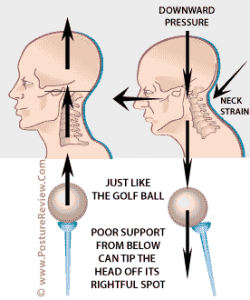 If your occupation requires that you work at a desk for long periods of time, then you are at a higher risk of developing chronic neck pain. The mechanism through which this neck pain occurs is essentially biomechanical. More specifically, it is due to an alteration in your head carriage that leads to large and undue forces being placed on the muscles and joints in your neck. These improper head postures, such as peering at the computer screen and adopting a “poking chin” posture, can also put unwanted pressure on the nerves of your neck. The problem lies in your constant repetition of these positions, which over time changes your head carriage to being “forward” of its ideal biomechanical position.
If your occupation requires that you work at a desk for long periods of time, then you are at a higher risk of developing chronic neck pain. The mechanism through which this neck pain occurs is essentially biomechanical. More specifically, it is due to an alteration in your head carriage that leads to large and undue forces being placed on the muscles and joints in your neck. These improper head postures, such as peering at the computer screen and adopting a “poking chin” posture, can also put unwanted pressure on the nerves of your neck. The problem lies in your constant repetition of these positions, which over time changes your head carriage to being “forward” of its ideal biomechanical position.
The main causes of neck pain at work are:
- Arm rests are positioned too high or too low;
- Telephone headset holds too tightly;
- Fatigue;
- Monitor height is too high or too low;
- Repetitive head movements;
- Improper head support;
- Frequently looking up and down;
- Continuous shoulder elevation;
- Improper lumbar posture; and
- Sitting at a very low height.
 The neck is the most flexible part of your spine and has the responsibility of supporting the weight and movement of your head, while also interacting with the upper back and the shoulder girdle. When the posture of your neck is compromised, it is susceptible to strain, tension, and fatigue. While this may not be an issue in the short-term, long-term exposure to poor head and neck posture can often lead to headaches, neck strain, and even degeneration of the bones, discs, and joints of the spine.
The neck is the most flexible part of your spine and has the responsibility of supporting the weight and movement of your head, while also interacting with the upper back and the shoulder girdle. When the posture of your neck is compromised, it is susceptible to strain, tension, and fatigue. While this may not be an issue in the short-term, long-term exposure to poor head and neck posture can often lead to headaches, neck strain, and even degeneration of the bones, discs, and joints of the spine.
As the head moves forward of its ideal alignment, the muscles at the front of the neck have a tendency of being overactive and short. Meanwhile, the muscles at the back of the neck, shoulder, and upper back tend to stretch and lengthen excessively. This can create a neck pain cycle that may be difficult to resolve without a specific corrective exercise program. Furthermore, if you embark on an exercise program either at a gym or with a personal trainer that does not address this forward head postural deviation, you are likely to exacerbate the problem, causing further pain and degeneration.
In order for you to prevent neck pain at work, the most critical thing for you to improve is your sitting posture. By improving your sitting posture, you are able to have a direct positive effect along the length of your spine, which will in turn have a positive effect on the position of your head and neck, with ultimate benefits in the longer term for your posture and alignment.
Here are some effective ways to prevent neck pain at work:
- Ensure that your office chair height is suitable to your height.
- Maintain a proper head support when you are working, watching TV, or travelling.
- To reduce frequent head movements, move the screen, document/folder and keyboard to an appropriate position that reduces your head movements.
- Use height-adjustable arm rests to your chair. Use a foot rest.
- Don’t keep your chair height too low.
- Use a monitor stand to place the monitor at a suitable height. If there is less desk space, then it is better to use a monitor arm.
- You should position the monitor at a height where the top of the monitor is at your eye level.
- If your feet are not in full contact with the floor then it is best to use a foot rest.
- Ensure that your seating is adequate.
- Use a telephone headset if making and receiving lots of calls throughout your day. This is the most common problem at the desk. Without a headset, you will experience problems like arm pain, neck pain, and muscle pain.
- Reduce the noise and light in your working environment to a comfortable level.
- Systematise your work to include frequent breaks away from the desk.
- Ensure that you correctly set up at your workstation.
- Regularly practice stretching exercises before going to bed and after waking up in the morning.
- Sit close enough to the monitor so that you don’t have to bend forward in order to see well.
 At Inspire Fitness, we are committed to identifying and then addressing our clients’ individual biomechanical deviations and limitations through corrective exercise techniques. The reason we do this is because we understand how important achieving optimal posture is to the long-term training effectiveness of our clients, and ultimately to their long-term health and fitness.
At Inspire Fitness, we are committed to identifying and then addressing our clients’ individual biomechanical deviations and limitations through corrective exercise techniques. The reason we do this is because we understand how important achieving optimal posture is to the long-term training effectiveness of our clients, and ultimately to their long-term health and fitness.
Understanding how to prevent your negative postural changes is the first step in achieving optimal posture and to reducing your risk of pain which results from any incorrect joint alignment with your body. The take away message? Take time to set up your computer workstation correctly using the recommendations above, and enjoy a healthy and pain-free lifestyle.
